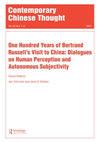《老子》零件顺序的新解释
IF 0.4
3区 哲学
0 ASIAN STUDIES
引用次数: 2
摘要
摘要本文认为,我们无法确定《老子》文本中“道”与“德”两部分的先后顺序。这两篇(篇)最初是老子独立写的,时间顺序不确定。它们最初是分开发行的,后来被不同的编辑组合在一起。由此产生了两个老子版本:“道”先于“德”的版本在传播中占主导地位;另一种顺序可以从最近发现的资料中检索,如马王堆帛书和汉竹简。本文章由计算机程序翻译,如有差异,请以英文原文为准。
A New Explanation of the Order of Parts in the Laozi
EDITOR’S ABSTRACT This paper argues that we cannot determine with certainty the sequence of the two parts of the Laozi text: “Way” (Dao) and “Virtue” (De). These two parts (pian) were originally written independently by Lao Zi and in an uncertain chronological order. They originally circulated separately, and were later combined differently by various editors. Thus emerged the two Laozi versions: The one with “Way” preceding “Virtue” has dominated the transmission; the alternative order can be retrieved from recently discovered sources such as the Mawangdui Silk Manuscripts and Han Bamboo Slips.
求助全文
通过发布文献求助,成功后即可免费获取论文全文。
去求助
来源期刊

CONTEMPORARY CHINESE THOUGHT
Multiple-
CiteScore
0.10
自引率
0.00%
发文量
0
期刊介绍:
This wide ranging journal is essential reading for anyone who wants to understand the diverse themes and influences that shape Chinese thought today. It features translations of the most current and influential Chinese writings on all aspects of philosophical endeavor, from theoretical essays on systems to studies of China"s cultural and religious development, from interpretations of the Chinese classics to exegeses on Marxist thought.
 求助内容:
求助内容: 应助结果提醒方式:
应助结果提醒方式:


